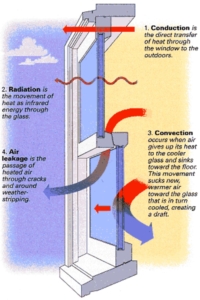A Quick Look at How Energy-efficient Replacement Windows in Omaha Work
When you’re faced with yearly weather conditions that would make your AC or heating system use massive amounts of costly energy on a daily basis, you might want to get energy-efficient replacement windows in Omaha, Nebraska or in Iowa.
To understand what exactly makes this a great option, you have to look into how the four types of heat transfer affect your home.

Conduction
Essentially, heat conduction happens when a solid with a higher temperature comes into contact with another of lower temperature, and the heat travels from the former to the latter. The part of your window heated by the sun can transfer this heat to anything that it comes into contact with, spreading the heat to your interiors.
Convection
The principle of convection states that heated vapor or air weighs less than cooled ones; hence the latter tend to drop much lower, while the former rises. In the winter, the hot air produced by your heater will come into contact with the cool glass pane of your conventional window, causing it to cool and drop quickly. This cycle is one reason why your heater can’t seem to keep your room completely warm.
Radiant Transfer
According to Fine Home Building, this is how radiant transfer works:
Radiant transfer is the warm feeling on your face when you stand near a woodstove. Conversely, your face feels cool when it radiates its heat to a cold sheet of window glass. But radiant-heat loss is more than a perception. Clear glass absorbs heat and reradiates it outdoors.
Air Leakage
Perhaps one of the easiest to comprehend, this is also one of the most common causes of rising home energy costs. In simple terms, air leakage occurs when the warm or cool air produced by your AC or heater escapes through small slits, cracks, or other holes in your home. Thankfully, you can eliminate this problem by having your home air sealed and insulated.
Energy-efficient windows in Iowa and Nebraska like those from Waddle Exteriors are designed to eliminate some or all of these problems. Multi-paned windows (with low-conductivity gases in between each pane) for instance, can significantly reduce the risk of heat escaping by convection, whereas thermally resistant window frames and edge spacers are excellent against heat conduction.
(Article Excerpt and Image from Understanding Energy-Efficient Windows, Fine Homebuilding)


